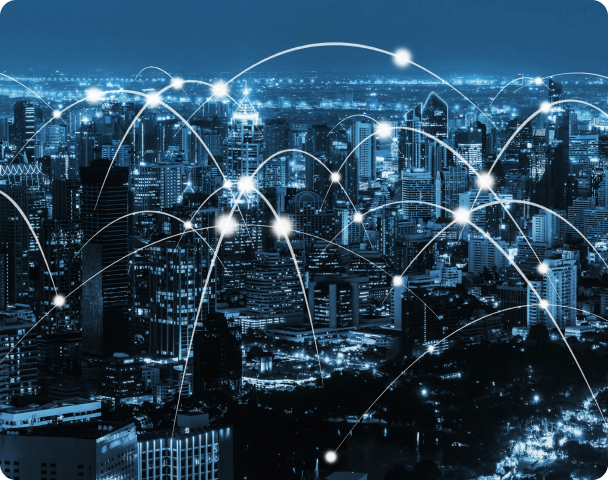7 Essential Business Strategies Empowered by IoT
Despite the recent economic downturn, global businesses have maintained a high pace of innovation and continue to bring IoT technology into wider use. As the benefits of IoT have become more apparent, companies have become more eager to apply these technologies to their core operations. In a chain reaction, the impact of IoT on the enterprise has added momentum to the adoption of other leading-edge technologies, such as Big Data and AI. All that translates to development of new business strategies that should address the challenges and opportunities of the post-crisis economy.
Data-driven LOB operations
During its early years, IoT used to be heavily centered around remote equipment monitoring, sensor data collection, and improved technical efficiencies. However, the focus has finally started to shift in favor of more business-oriented process automation.
Line-of-business (LOB) operations are now a major target of IoT since many companies have already tested it on small-scale projects and are willing to go ahead with strategic implementation. There is also greater clarity and plenty of real-life examples of how IoT may be used in specific LOB operations to capture business value.
For example, manufacturing companies are able to go beyond basic equipment monitoring solutions to enable predictive maintenance with additional analytics and automated workflow management. As a result, adoption of IoT technologies ensures maximum uptime, speeds up critical decision making, and simplifies workload management on the factory floor.
In a similar way, logistics companies combine vehicle tracking and telematics solutions with cargo tracking, RFID-based warehouse management, and workforce management applications to build fully transparent supply chains for their clients. IoT has given these companies a competitive advantage and strong foundation for their business development.
Analytics at scale
The unprecedented amount of data generated by IoT devices and sensors makes Big Data analytics indispensable to global business development. However, only a fraction of companies have been able to successfully monetize IoT data so far. This trend is about to change with data science rapidly gaining steam.
Data science and Big Data technologies have been used in advertising, Telecom, and IT infrastructure management. Now they are being paired with smart connected devices to harvest an abundance of IoT data in a broad variety of business domains. For example, consumer data analytics have been effective to help understand user preferences, discover potential product improvements, and manage advertising and marketing campaigns. In healthcare, real-time patient data analytics is the leading edge innovation for all types of wearable and stationary medical devices.
Analytics also helps companies save money. Predictive analytics is one of the most popular IoT solutions that helps reduce equipment maintenance cost and prolong the lifespan of modern devices. There are also other Big Data/IoT applications used to cut back operational costs in cases ranging from validating warranty claims on leased equipment to balancing rented cloud server capacity to meet the customer SLAs. However, in order for companies to choose an analytics solution among the vast number of options in the market, they must first focus on clarifying their monetization strategies. That knowledge will help them thread their way through data analytics implementation challenges, as well as find a perfect IoT platform for their device analytics.
Cloud as a core expertise
Cloud computing is at the heart of IoT. Modern smart devices function through cloud infrastructures, private or public. That’s where data processing, device management, and business process automation now usually happens. Migrating data and legacy applications to the cloud are the first steps towards modern IT management, and IoT expedites this transition.
For this reason, companies must get really involved with their cloud strategies and figure out when it’s better to use ready-to-go SaaS/PaaS, a public cloud hosting, or their own data centers. For example, to kickstart your company’s digital transformation, you can first take advantage of no-hassle SaaS solutions, which require zero prior expertise. But as your cloud expertise grows, you can build more custom-designed solutions or even become an SaaS service provider yourself. IoT opens up a myriad of opportunities.
To help companies of all sizes and business profiles succeed with IoT, the popular Kaa IoT Platform comes in 3 different formats - entry-level Kaa Cloud as well as custom-tailored KaaIoT-hosted Kaa instance and self-hosted Kaa instance. There are also whitelabeling and platform redistribution available as options.
Customer-centric digital transformation
IoT-powered products create multiple new ways for companies to interact with their customers. Most of these products support a variety of options for new services and have a great potential to bring personalized user experiences into play. In fact, in fields such as consumer electronics, healthcare, hospitality and retail, customer-centric digital transformation is the biggest promise of IoT. Are businesses ready to deliver personalized experiences yet?
Not many of them. Some major impediments include the half-hearted scale of IoT implementations and numerous misconceptions about IoT data analytics. Lack of consolidated digital strategies also slow down the progress. These issues make the role of Chief Digital Officer critical in streamlining the digital transformation across separate departments of a company as well as in striking a chord among shareholders.
To get results fast and not get lost in the overall “digitization” effort within a company, user experience must be a key priority. By using IoT, go-to-market strategies for new products will become more user-centric and based on previously collected user data. And it seems fair to say that IoT data is a valuable resource that helps companies like Tesla worth more than Ford and GM and unlocks a previously unseen variety of monetization strategies for every business.
Establishing data-driven business partnerships
IoT is increasingly a space for exciting business collaboration. Collected in one application, customer data often has collateral value for various other applications. For example, insurance companies could benefit from clients’ health stats provided by health monitoring devices. In practice, some companies already distribute fitness trackers among their clients and reward them for meeting their fitness goals.
On a larger scale, partnerships between different companies can result in unique innovations and more comprehensive IoT solutions. This is particularly the case for wide-area projects such as Smart City or Smart Energy, but also applies whenever companies can complement each other’s technology stack, service portfolio or customer data set. Consider a Telecom operator that partners with a smart home vendor and enables 24/7 managed services for smart home users. In other use cases, they can sell subscribers’ preferences analytics to over-the-top (OTT) providers, support businesses with location-based advertising, or lend their infrastructure edge to third-party applications.
There are countless opportunities for every sector, so revisiting partnership strategies might be a key part of a successful IoT integration. Having a good command of IoT enablement technology - such as an IoT platform, cloud, and analytics - gives you a wide variety of options to engage in such partnerships.
Reshoring via innovations
Even though global operations are critical to many companies' success, some businesses find it necessary to return part of their product manufacturing from foreign soil. There’s a number of reasons for this trend, especially in the US, such as eliminating the country’s goods trade deficit, adding jobs, and reducing critical dependencies on other countries.
That said, blind protectionism can do more harm than good in the long run. International businesses take advantage, among other things, of labor cost differences between regions to stay efficient and competitive. That way they create growth for the global economy. However, if you cannot compete on price, you can still boost efficiencies via innovations, such as IoT solutions for manufacturing and smart factories.
One example of effective reshoring is the Adidas “Speedfactory” in Atlanta. The plant was designed to be 3 times faster than its counterpart in Europe and required a workforce 6 times smaller than similar plants in Asia. Using modern industrial automation solutions and IoT, manufacturers can introduce latest technologies in their more expensive home regions and then gradually expand innovations to production sites elsewhere. By doing so, they will always be one step ahead with their onshore efficiency and product quality while also making good use of offshore facilities and human capital.
Preparing for AI
AI has been in the spotlight for some time already, making an especially convincing case in predicting what users want in all kinds of settings. According to the latest reports, automated recommendations are responsible for more than a third of what people buy on Amazon and around three quarters of what they watch on Netflix! Facebook is also among the AI frontrunners as it uses machine learning to recognize and display relevant texts, photos or videos to users.
IoT will bring a lot more AI-infused opportunities to life. Following in the footsteps of online giants, smart device vendors may use AI to delve into user behavior data in order to continuously enhance their products’ UX and introduce new value-added services. Virtual assistants, voice and image recognition, and AR applications are all set to dramatically expand the capabilities of modern smart devices.
AI can also effectively complement IoT by reducing the cost of physical operations. Some logistics companies, for example, use robots in their fulfillment centers, and also apply AI to categorize inventory and decide shipping logistics. Agriculture companies already use drones and computer vision applications to monitor their fields and decide the optimum harvest time.
Even if AI is not exactly up your alley at the moment, it is time to at least start taking it seriously. So be prepared and never stop innovating.




